Reserve Bank of Australia Annual Report – 2006 Operations in Financial Markets
The main reason the Reserve Bank operates in financial markets is to implement its monetary policy decisions. It also, however, undertakes a large volume of transactions on behalf of clients, particularly in foreign exchange markets, and transacts on its own account to manage its holdings of financial assets.
Over recent years two forces have been shaping the way the Reserve Bank conducts its operations. First, its balance sheet has expanded substantially, mainly because of deposits placed by the Australian Government from the proceeds of its budget surpluses. Over the past four years, the balance sheet has increased by more than 75 per cent, to over $100 billion, with the majority of the rise owing to larger Government deposits, including recently those of the Future Fund. Second, there has been a decline in outstandings of Commonwealth Government securities (CGS), the securities that had traditionally formed the staple of the Reserve Bank's market operations. To accommodate these two forces, the Reserve Bank has broadened the range of domestic securities in which it is prepared to deal and made more use of foreign exchange operations to manage domestic liquidity.
The result has been a substantial change in the composition of the balance sheet. Compared with four years ago, holdings of CGS (including under repo) have halved, to around $7 billion, while holdings of other domestic securities have risen strongly. The largest rise in assets, however, has been in foreign exchange holdings. Including amounts held under swaps, holdings of foreign exchange have increased by about $30 billion over the period, accounting for about three-quarters of the expansion of the balance sheet. This has reduced the pressure on domestic securities markets resulting from the contraction in government debt.
None of these developments has undermined the effectiveness of the Reserve Bank's operations. While there has been some increase in risk on the balance sheet, in terms of interest rate, exchange rate and credit exposures, it remains very well covered by the Reserve Bank's capital position. Moreover, much of the recent expansion of the balance sheet is likely to prove temporary as the Future Fund withdraws deposits to invest in other assets.
Domestic Market Operations
Monetary Policy Implementation
Decisions about the stance of monetary policy in Australia are expressed in terms of a target for the cash rate. This is the interest rate payable on overnight, unsecured loans between banks. Its relevance for policy is that it is an important determinant of other wholesale and retail interest rates, which, in turn, affect the level of economic activity and inflation. The Reserve Bank implements its policy decisions by undertaking transactions with financial market participants on a daily basis to ensure the actual level of the cash rate remains close to the target.
The target for the cash rate was increased by 25 basis points at the May 2006 and August 2006 Board meetings; these rises lifted the cash rate to 6.0 per cent. This was part of a gradual tightening cycle that began in 2002. The background to policy changes is provided through the media releases announcing each change, and subsequently in the quarterly Statement on Monetary Policy and in appearances by the Governor before the House of Representatives Standing Committee on Economics, Finance and Public Administration.
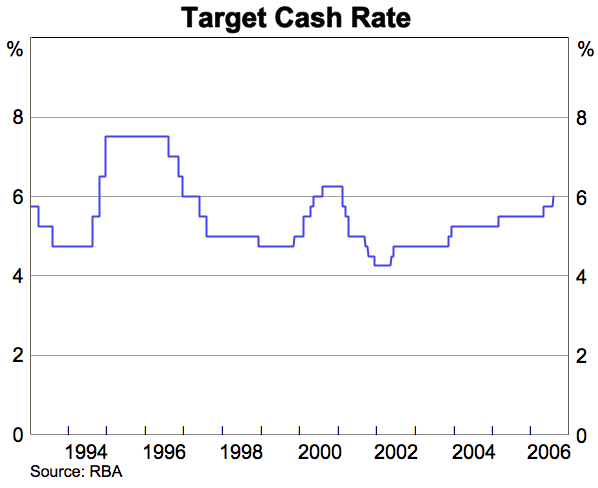
To ensure that the cash rate remains as close as possible to the target, the Reserve Bank undertakes daily operations in the market to adjust the aggregate amount of funds held in commercial banks’ Exchange Settlement (ES) accounts at the Reserve Bank. Adjusting the supply of ES funds provides control over the cash rate because banks have a clearly defined demand for these funds. They are the means used by banks to settle their payment obligations with one another (and with the Reserve Bank), and so banks must maintain sufficient holdings to meet expected obligations.
Over recent years, banks in total have sought to hold around $750 million in ES accounts. If the supply were to fall below this level for any sustained period, some commercial banks would find themselves holding insufficient balances and would look to restore their holdings by bidding more aggressively for funds in the money market, putting upward pressure on the cash rate. Conversely, because these funds earn interest at slightly below market rates, if supply were to rise above that needed for payment obligations, banks would seek to reduce their unwanted holdings by offering funds in the market, thereby putting downward pressure on market interest rates.
This system of market operations is well understood by market participants and is efficient in maintaining control over the cash rate. Day-to-day volatility in the Australian cash rate is low by international standards.
| Number of Times Used |
Total Value of Drawings ($ million) |
|
|---|---|---|
| 2000/01 | 18 | 2,611 |
| 2001/02 | 11 | 673 |
| 2002/03 | 14 | 1,673 |
| 2003/04 | 24 | 2,159 |
| 2004/05 | 11 | 1,394 |
| 2005/06 | 10 | 436 |
Open market operations are conducted each morning. On rare occasions, a second round of operations may be undertaken later in the day to offset large unexpected flows or sudden shifts in demand for ES balances. In 2005/06, there was just one second-round operation.
To supplement the daily market operations undertaken by the Reserve Bank, banks also have a standing facility under which they can borrow funds overnight from the Reserve Bank on a secured basis, at their discretion but at 25 basis points above the cash rate target. Banks typically use this facility when there are technical factors that prevent them from sourcing funds from the market. In 2005/06, the facility was accessed on 10 occasions, about the same as in the previous year, while the average size of overnight loans declined to less than $50 million.
Total turnover in domestic securities for market operations in 2005/06 was around $420 billion, a little higher than in the previous year. The bulk of these operations were repurchase agreements (‘repos’), which involved the purchase of securities with an agreement to re-sell at a set future date and at a set price. The high use of repos largely reflects the flexibility that they offer for managing liquidity flows, since their maturity can be tailored to meet expected flows. Outright purchases and sales of securities remained modest.
Domestic operations were augmented with foreign exchange swaps. These involve the exchange of one currency for another with an agreement to reverse the transaction at an agreed exchange rate and on an agreed date. In terms of managing domestic liquidity flows, they have similar effects to domestic repos, in that they can be used to add or subtract Australian dollars from the banking sector. The difference is that they do so in exchange for foreign currency rather than domestic securities. Turnover in foreign exchange swaps involving the Australian dollar rose substantially during the year, to over $150 billion (see below for more details).
As noted above, the Reserve Bank has changed its dealing arrangements in recent years to allow for the reduced amount of CGS on issue. These changes have broadened the range of securities in which the Reserve Bank is prepared to deal. The most recent changes were made in early 2004, when the range of eligible securities was widened to include domestic bank instruments and a broader range of foreign government and supranational paper. The benefits of this change have become even more apparent in the past year, given the further strong growth in the Reserve Bank's balance sheet. The total repo book rose to $26 billion by June 2006, up from around $17 billion a year earlier. Most of the overall rise was in repos collaterised by bank bills and certificates of deposit (CDs), which almost trebled to $14 billion. Repos in CGS have declined over recent years.
| 2000/01 | 2001/02 | 2002/03 | 2003/04 | 2004/05 | 2005/06 | |
|---|---|---|---|---|---|---|
| Repurchase agreements(a) | ||||||
| – Purchases | 376 | 423 | 304 | 272 | 391 | 409 |
| – Sales | 17 | 16 | 17 | 11 | 10 | 6 |
| Outright purchases(b) | 5 | 1 | 3 | 5 | 5 | 4 |
| Total operations in domestic securities | 398 | 440 | 324 | 287 | 405 | 419 |
| Foreign exchange swaps(a) | 90 | 90 | 90 | 139 | 106 | 157 |
| Total | 488 | 530 | 414 | 426 | 511 | 576 |
|
(a) First leg of transaction. (b) CGS only until 2002/03. Thereafter includes State and Territory government securities. |
||||||
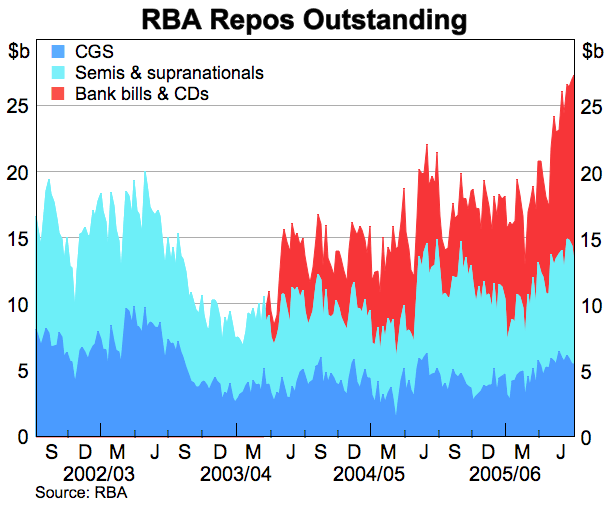
In addition to the repo operations noted above, the Reserve Bank continued to rebuild its outright holdings of domestic securities through secondary market purchases of longer-dated securities issued by the State and Territory borrowing authorities (semis). As in the previous year, small parcels (around $100 million) were purchased at regular intervals throughout the year. In total, nine operations involving longer-dated securities were undertaken, bringing the value of semis in the domestic portfolio to around $1.6 billion. These operations have been undertaken to offset to some degree the decline in outright holdings of longer-dated CGS.
Securities Lending
The Reserve Bank maintains a securities lending facility through which it is prepared to lend to market participants any domestic securities that it holds on an outright basis on its balance sheet. This assists the flow of stock through the market and helps market participants meet their settlement obligations.In addition to these operations, which involve its own holdings of securities, the Reserve Bank operates a stock lending facility on behalf of the Australian Office of Financial Management (AOFM). This facility allows participants to obtain access to any line of Treasury bonds, but at a penalty relative to market prices for stock lending.
Both the value and volume of securities lending transactions have risen significantly in recent years. In part this is a response to the tightening supply of government securities, which has increased the demand by market makers to borrow stock to meet settlement obligations. In 2005/06, the value of stock lent from the Reserve Bank's portfolio rose by 70 per cent to over $20 billion, after having more than doubled in the previous year. Loans are, however, generally only for short periods and the average amount of stock on loan at any one time was about $500 million. Earnings on these transactions rose to around $890,000. Stock lending transactions on behalf of the AOFM were relatively small in comparison, at around $1.2 billion, reflecting the ‘last resort’ nature of that facility.
| Number of Transactions |
Amount Lent (face value, $ billion) | Net Income ($ million) | |
|---|---|---|---|
| 2000/01 | 75 | 1.2 | 0.05 |
| 2001/02 | 119 | 3.1 | 0.27 |
| 2002/03 | 32 | 0.9 | 0.13 |
| 2003/04 | 185 | 5.0 | 0.50 |
| 2004/05 | 264 | 11.9 | 0.56 |
| 2005/06 | 460 | 20.3 | 0.89 |
Foreign Exchange Operations
The Reserve Bank's foreign exchange operations in 2005/06 centred around two main tasks. The first was to meet the foreign exchange needs of the Australian Government and other clients. Over the course of the year, $4.7 billion of foreign exchange was sold to the Government, an amount broadly in line with that in the previous year. This foreign exchange is needed by the Government to cover overseas costs, such as defence expenditure, embassy running costs and foreign aid. The Reserve Bank covered these sales by buying foreign exchange in the market. This is normal practice unless the exchange rate is unusually low, in which case some of the Government's foreign exchange needs may, on occasion, be met from foreign currency reserves.
The second task was to assist in domestic liquidity management through foreign exchange swaps. As noted above, the increase in Government deposits at the Reserve Bank over the past year withdrew Australian dollars from the money market. One of the ways in which the Reserve Bank replenished these was to buy an increased amount of foreign exchange under swap agreements. (These transactions involve the Reserve Bank receiving foreign exchange from its counterpart and paying Australian dollars.)
Over the course of 2005/06, the Reserve Bank's holdings of foreign exchange under swaps increased from $30 billion to $34 billion. Swaps generally have a relatively short maturity, typically between two and three months. As such, the increased holdings of swaps led to a substantial increase in turnover, to $157 billion.
The Reserve Bank did not undertake any foreign exchange operations in 2005/06 intended specifically to influence the exchange rate of the Australian dollar. Such transactions, known as intervention, are typically undertaken when the exchange rate has moved a long way from its normal level, and in a manner that is inconsistent with Australia's economic conditions. With the Australian dollar moving in a relatively narrow range during the year, at a level a little above its long-run average, the Reserve Bank saw no need to try to influence the exchange rate. The Reserve Bank has not intervened in the foreign exchange market since 2001.
The Reserve Bank also scaled back its reserves replenishment operations during the past year. After the period of intervention from 1997 to 2001, when the Reserve Bank sold reserves holdings to support the Australian dollar, a process of rebuilding reserves was begun once the exchange rate had recovered. While the primary aim of these operations has been to ensure that reserves holdings are adequate, consideration has also been given to cost. Because the cost of buying foreign exchange decreases as the Australian dollar rises, purchases have been skewed towards periods of greatest strength in the exchange rate. Including earnings, the addition to reserves peaked at $10.9 billion during 2003/04, when the Australian dollar rose sharply to around US80 cents. Since then, with the exchange rate declining from its earlier peaks and reserves at relatively comfortable levels, additions to reserves were scaled back. In 2004/05, they amounted to $3.8 billion and, in the year just ended, to $2.3 billion.
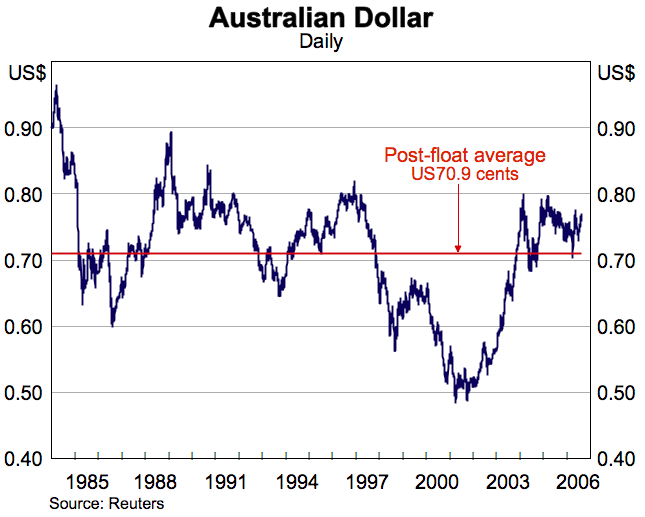
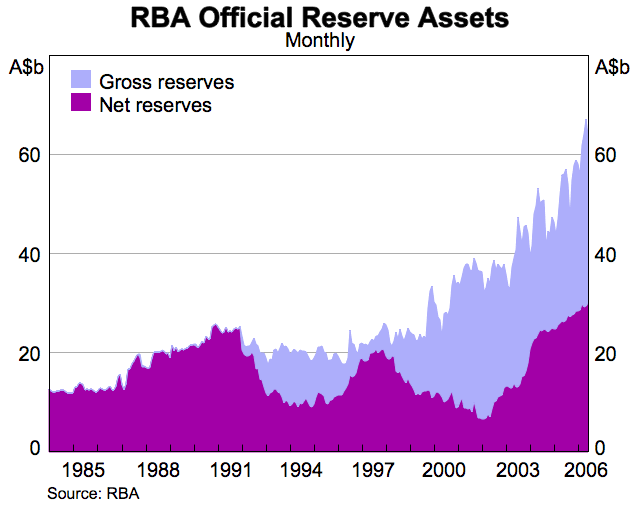
At the end of June, net official reserves stood at $30 billion, up from $26 billion at the end of the previous financial year. In addition to purchases noted above, the rise reflected some valuation gains resulting from a fall in the exchange rate of the Australian dollar against the currencies in which reserves are held. This level of reserves holdings is adequate to meet Australia's needs. Nonetheless, it accounts for only about one-third of the Reserve Bank's assets, so there is scope to add further to holdings if the exchange rate were to rise to a level where this was advantageous. Taking into account also the $34 billion held under swaps, total official reserve assets at June 2006 were $64 billion, an increase of $8 billion over the year.
Reserves Management
Australia's official reserve assets are held and managed by the Reserve Bank. They consist mainly of holdings of government securities and bank deposits in a range of foreign currencies. Given that these assets may be required at relatively short notice to fund intervention, priority in investing them is given to liquidity and security. Within these constraints, the funds are managed with the aim of maximising returns.
The assets are managed against a benchmark that defines risk/return characteristics acceptable to the Reserve Bank. A key feature of this benchmark is asset and currency composition. The United States and Europe both have equal weight, at 45 per cent each, while Japan has a weight of 10 per cent. The other key feature of the benchmark is the duration (or weighted average maturity) of investments. This is set at 30 months for each portfolio, with the maximum term to maturity of any security being 10.5 years. In addition to these broad characteristics, the benchmark defines the types of assets that can be held, particularly in relation to credit risk. Changes to the benchmark are infrequent. The last major change occurred in February 2002, when the weight applied to Japanese investments was reduced from 30 per cent, with increased weight given to the other currencies, particularly the euro.
| US | Europe | Japan | |
|---|---|---|---|
| Asset allocation (% of total) | 45 | 45 | 10 |
| Currency allocation (% of total) | 45 | 45 | 10 |
| Duration (months) | 30 | 30 | 30 |
In managing the foreign assets, the portfolio managers are constrained to a relatively narrow range around the benchmark. However, they have some discretion to move away from benchmark to take advantage of cash management strategies and short-term market anomalies. Some tolerance for deviation from benchmark is also necessary given the operational practicalities of managing a large and diverse portfolio that is constantly changing in size. Rigid adherence to the benchmark in such circumstances would result in a significant amount of high-frequency, and largely offsetting, trading to fine-tune portfolio composition.
With market yields rising in all the major countries, the past year was a difficult one for fixed income investments, which make up the bulk of the reserves holdings. Capital losses on bonds kept returns low in each of the three countries in which investments are held. In fact, as shown below, the return on investments in Japan was negative, at −0.9 per cent. In Europe, the return was 0.1 per cent, while in the US it was 1.2 per cent. These returns were below average, though not dissimilar to those in 2003/04, also a year of rising bond yields.
| US | Europe | Japan | |
|---|---|---|---|
| 2000/01 | 8.6 | 5.7 | 2.3 |
| 2001/02 | 6.1 | 4.7 | 0.4 |
| 2002/03 | 6.6 | 7.2 | 1.3 |
| 2003/04 | 0.0 | 1.9 | 0.0 |
| 2004/05 | 4.1 | 5.8 | 1.1 |
| 2005/06 | 1.2 | 0.1 | −0.9 |
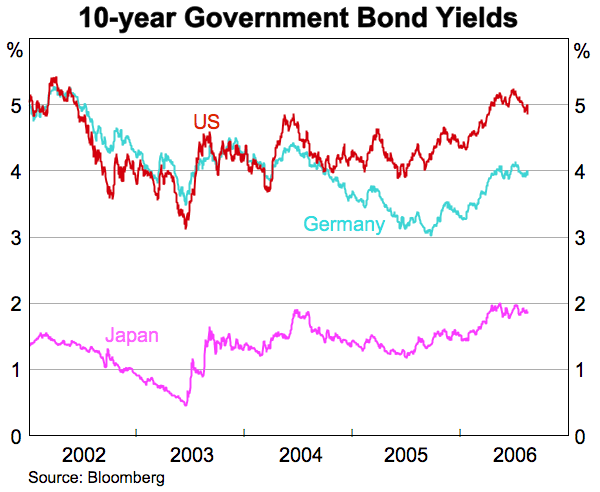
Aggregating returns across the different regions requires the use of a common yardstick. The one the Reserve Bank uses is the SDR, a composite of the world's major currencies. On this basis, the total return on the reserves portfolio in 2005/06 was 1.2 per cent. This was below the average return achieved over the longer run, but again not very different from 2003/04.
The benchmark portfolio would have returned 1.0 per cent. The decisions taken by portfolio managers contributed another $55 million, or 17 basis points, to actual returns for the year. This contribution was similar to the average of recent years. About two-thirds of this contribution came from portfolio managers taking positions that deviated from benchmark, while the rest came from lending securities. Of the returns that came from deviating from benchmark, the major contribution came from maintaining the actual portfolio duration a little short of benchmark. This was a favourable strategy in a rising interest rate environment.
| Rates of Return in SDR (per cent) | Value of Difference (A$ million) | ||
|---|---|---|---|
| Actual | Benchmark | ||
| 2000/01 | 11.0 | 10.8 | 74 |
| 2001/02 | 3.9 | 3.7 | 63 |
| 2002/03 | 6.7 | 6.4 | 77 |
| 2003/04 | 0.5 | 0.3 | 67 |
| 2004/05 | 4.7 | 4.5 | 38 |
| 2005/06 | 1.2 | 1.0 | 55 |
A small proportion of foreign currency reserves continues to be invested in the two Asian Bond Funds. These funds comprise portfolios of debt issued by a number of Asian sovereign and quasi-sovereign borrowers – one is a fund that invests in their US dollar-denominated debt and the other is a fund that invests in their local-currency debt. The US dollar-denominated fund (ABF1) returned ‑1.0 per cent in 2005/06. This was less than the return of 1.2 per cent on the return on the Reserve Bank's holdings of US securities and deposits, because of the rise in spreads late in the year on some of the debt held in the Fund. The return on the local-currency denominated fund (ABF2) was significantly higher, at 5.7 per cent, because of favourable exchange rate movements.
As part of official reserve assets, the Reserve Bank holds around 80 tonnes of gold, valued at about $2.2 billion at the end of June. In past years, all this gold was on loan to gold dealers, on a fully collaterised basis. Over the past year, however, demand for gold loans fell sharply and interest rates on such loans fell to zero for maturities out to one year and only 28 basis points for maturities out to five years. In this environment, the Reserve Bank has not been prepared to make any new loans, and repayments reduced the amount of gold on loan to 53 tonnes at the end of June. Returns from gold lending for 2005/06 declined only marginally, however, as income was sustained by ongoing receipts from loans entered into in earlier years at higher interest rates; total interest income on gold loans for the year was $13.4 million, compared with $15.5 million in 2004/05.